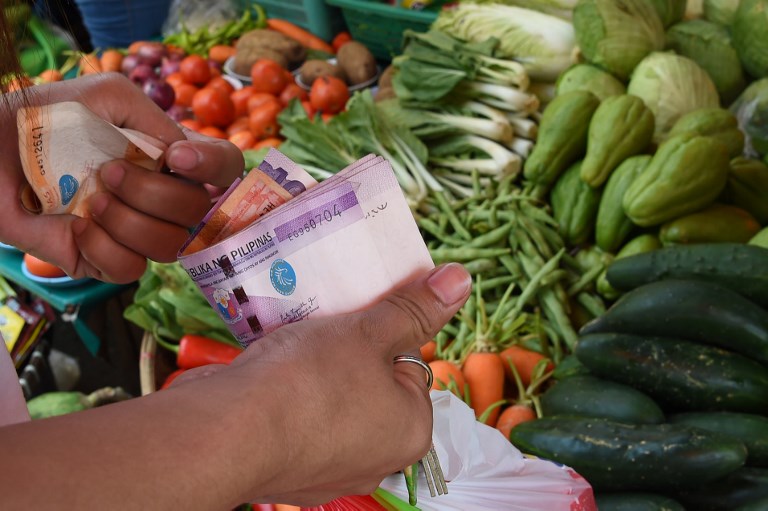PH urged to brace for impact of global inflation, Fed hikes

A customer buys vegetables at a market in Manila on Oct. 5, 2018. A February 2022 World Bank report warns of the impace of global inflation. (INQUIRER FILE PHOTO)
MANILA, Philippines — Philippine monetary authorities must brace for higher global inflation and the US Federal Reserve’s rate hikes coming soon and fast, but economists watching the country have varied forecasts when domestic interest rates would follow suit.
In a report last week, the World Bank’s Philippine office said that while local inflation already settled within the government’s 2 to 4 percent target range, “rising US inflation and forthcoming monetary policy tightening are developments for policymakers to watch out for.”
The Bangko Sentral ng Pilipinas (BSP) already acknowledged the risks from US Fed normalization. Citing the Fed’s signal in January that a rate hike could be forthcoming as early as March, the BSP said “a gradual adjustment in US interest rates could help arrest possible rise in financial vulnerabilities from the unprecedented policy support amid the global pandemic.”
“However, unexpected increases in US interest rates could lead to tighter global financial conditions and weigh on the recovery process of emerging market economies, including the Philippines,” the BSP said in its February monetary policy report published last Friday.
The BSP projected the US federal funds rate to rise to 1.4 percent this year and further climb to 1.9 percent next year, through four rate hikes in 2022 plus three hikes in 2023. “The federal funds rate is expected to rise starting in March 2022 based with a 25-basis point (bp) hike in each succeeding quarter until the third quarter of 2023 based on the latest futures path,” the BSP said.
Financial institutions and economic think tanks expect the Philippines’ own policy rate, kept at the record-low 2 percent last week, to be raised while the BSP balances upside risks to near-term inflation and a still fragile economic recovery while unwinding its liquidity support, which kept the economy afloat amid the prolonged pandemic.
Normalization
After Governor Benjamin Diokno last week signaled moves toward normalization, Deutsche Bank Research said it expects the BSP to be “relatively aggressive” compared to its Asean peers and jack up key interest rates by a total of 125 bps this year, starting in its next meeting on March 24. In particular, Deutsche Bank projected 25-bp hikes each in the first, third and fourth quarters, plus 50 bps during the second quarter.
“In the Philippines, our rates forecast implies a 1.5-percent rise in real rates this year, which we think is appropriate, given their higher inflation rate,” Deutsche Bank chief economists Juliana Lee and Michael Spencer said in a Feb. 17 report. The BSP last week jacked up its inflation forecast for 2022 to 3.7 percent from 3.4 percent previously due to upside risks from expensive oil and higher domestic food prices.
Singapore-based United Overseas Bank projected a total of 75 bps in interest rate hikes in 2022, “with a 25-bp increase in each quarter starting from the second quarter,” UOB senior economist Julia Goh and economist Loke Siew Ting said.
Aggressive Fed
“It is premised on an expected more aggressive Fed tightening, solid upturn in domestic growth, and rising demand price pressures in tandem with improving economic activities towards yearend,” UOB said.
“The Philippine government on Feb. 10 reopened its borders to fully vaccinated tourists from more than 150 countries, without having to undergo facility-based quarantine, to boost the nation’s economic recovery. Tourism accounted for 12.7 percent of the Philippine economic output in 2019. This, alongside improving vaccination rates and better management of the pandemic in the country will help restore real GDP (gross domestic product) growth to a more solid pace. This justifies a gradual unwinding of pandemic-related aids,” UOB added.
In a Feb. 17 report, ING Philippines senior economist Nicholas Mapa said he expected “a late second-quarter policy rate hike given a likely strong first-quarter GDP report.”
Investment banking giant Goldman Sachs sees normalization starting, yet conservatively, by the second half. “Over the course of the year, as activity continues to improve, inflation pressures build and global risk-free rates rise, we expect the BSP to tighten policy settings by hiking policy rates once in the second half of 2022,” Goldman Sachs Economics Research said in a Feb. 17 report.
Both UK-based think tanks Capital Economics and Pantheon Macroeconomics maintained their stance that the BSP will defer any rate hike this year as economic growth was still on a catch-up mode.
Pantheon Macroeconomics senior Asia economist Miguel Chanco said in a Feb. 18 report that the waiting time for the BSP’s normalization “will be long.” For Chanco, “slack defines this [the Philippines’] economy, more than most, and we see no chance of inflation breaching the target.”
In a Feb. 18 report, Capital Economics senior Asia economist Gareth Leather said the Ukraine-Russia crisis could jack up oil costs and impact more on emerging Asia’s oil-importing economies. But Leather said that “central banks in Southeast Asia, where inflation is generally less of a worry and recoveries less advanced, would be more likely to ‘look through’ a rise in oil prices.”
RELATED STORIES
PSEi cools down to gauge Fed, Ukraine developments
Bargains save PSEi from Ukraine, Fed concerns